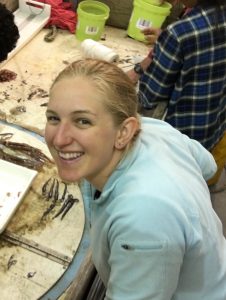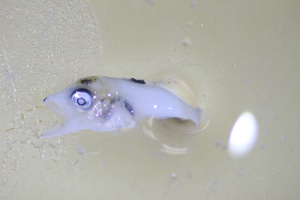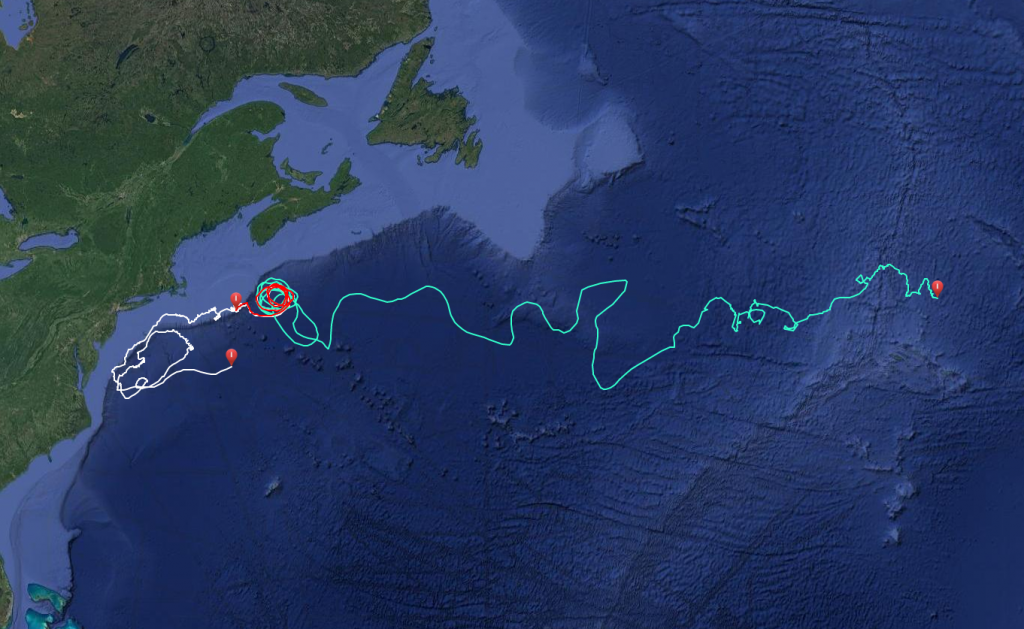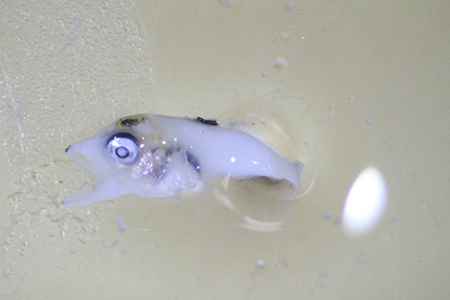Atlantic Bluefin Larvae Project
In June 2016, Christina Hernandez (shown on the right) and Joel Llopiz began to explore “Atlantic Bluefin Tuna spawning in the Slope Sea: larval growth and retention” while at the Woods Hole Oceanographic Institution with collaborator Glen Gawarkiewicz. The team planned to build and deploy 4 sets of drifters (3 drogued drifters to be released together) in the Slope Sea, an area between the Gulf Stream and northeast U.S. continental shelf, aboard the NOAA Gordon Gunter in June of 2017. “We are hoping to find patches of larval bluefin tuna where we can release drifters that will track the movements of the water surrounding the larvae as they grow.” Chrissy said in a blog entry. And while they collected plankton samples day and night, they did not find the evidence they were looking for in order to launch the drifters.

More from the Gunter cruise blog:
- Atlantic bluefin tuna are one of the iconic marine fish species. Over the course of their seasonal migrations, individual bluefin tuna can occupy both nearshore and oceanic waters, swim across the ocean, and cross through international waters and the exclusive economic zones of multiple nations. These migrations expose bluefin tuna to a wide variety of fisheries, a factor that presents a notable challenge to managing this species.
- In recent decades, the common view of Atlantic bluefin tuna was that they spawned only in two places, the Mediterranean Sea in the Eastern Atlantic and the Gulf of Mexico in the western Atlantic. However, in the summer of 2013 two cruises sampled the Slope Sea, both of them achieving noteworthy catch rates of early-stage bluefin tuna larvae. These collections were consistent with a hypothesis first put forward in the 1950s that the Slope Sea was a third spawning ground for this species. Follow up sampling in 2016 again achieved notable catch rates of bluefin tuna larvae.
- Researchers aboard the NOAA Ship Gunter are evaluating the distribution and abundance of bluefin tuna larvae in the Slope Sea spawning ground. This cruise is sampling earlier in the season than previous Slope Sea cruises to provide us information on the regional start of the spawning season for this species.
- While the focus of this cruise is on Atlantic bluefin tuna, one other exciting aspect of the project is that we are not certain of the full suite of other species we might collect or observe during visual surveys. The Slope Sea has long been hypothesized to be important in the life history of other species, besides Atlantic bluefin tuna, that support economically valuable fisheries off the northeast United States.
So in July, aboard the R/V Henry Bigelow they went, joining the turtle tagging team. They set out to address several research questions by towing neuston and bongo nets that are sampling at varying parts of the water column: “First, what plankton are found in these regions and under these environmental conditions, specifically, in the frontal zones between warm and cold waters? Second, are there any particular fish larvae found in the plankton that would help us improve understanding of the spawning locations? Third, can we use video recording to measure the presence of gelatinous zooplankton in the water, a major food source for leatherback turtles and, occasionally, loggerhead turtles as well?” The second question is what Chrissy’s focus was on.
2017-2018 Deployments
July 2017
While traveling in and out of a warm core ring and identifying a few larvae from the plankton tows on July 11, the first 3 drifters were deployed. We thought the two deployed off the stern might have been tangled in the first day or two (halfway around the ring) but they appeared to separate eventually.

Blog from the Bigelow Ship July 11: “Our cruise track for the past few days has us (at night) going in and out of a warm core ring, which is a chunk of water from the Gulf Stream (so it’s warm and salty) that has spun away from the Gulf Stream and is now traveling up along Georges Bank (southeast of Cape Cod). What’s really interesting about sampling this warm core ring is that you can find completely different sets of animals when you do a tow inside or outside of the ring. So you can find tropical species in one tow, and more typical species for coastal New England in the next tow depending on where the ship is.”
The three drifters had very different fates…

August 2017
One of the drifters (ID = 176400673) was taken out of the water by F/V Sea Angel in early August. Chrissy met Capt Katz at the BlueWater Fisheries dock in Fairhaven and recovered all but the drogue. It appears the screw pin shackle may have come undone.
October 2017
One drifter (ID=176400671) spent an unusually-long time on the shelf edge after emerging from the ring before it finally advected along the shelf with help from Tropical Storms Jose and Maria. In early October, it was still in the shelfbreak jet off Delaware but eventually went silent in mid-December.
January 2018
One drifter (ID=176400672) headed out to sea into the Gulf Stream after a few rotations in the ring and was beyond the Azores in early Jan 2018..

In the News
A nice article was written in WHOI’s OCEANUS magazine about this work called “The Secret Tuna Nursery“.

